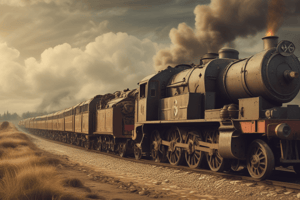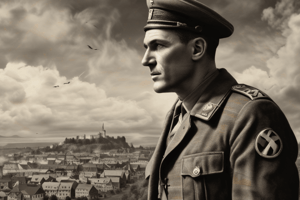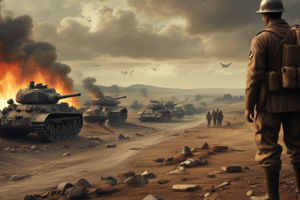Podcast
Questions and Answers
What was the outcome of the Munich Conference in 1938?
What was the outcome of the Munich Conference in 1938?
- The Sudetenland was given to Germany in exchange for a pledge of peace (correct)
- The Axis powers were dissolved
- Germany declared war on France and Britain
- Hitler was forced to withdraw his troops from the Rhineland
What was the main purpose of the Nonaggression Pact signed in 1939?
What was the main purpose of the Nonaggression Pact signed in 1939?
- To form an alliance between Germany and Britain
- To allow Hitler to invade Poland while giving Stalin the eastern half (correct)
- To establish a permanent peace in Europe
- To dissolve the Axis powers
What was the name of the air force created by Hitler under his rearmament program?
What was the name of the air force created by Hitler under his rearmament program?
- Sturmabteilung
- Wehrmacht
- Luftwaffe (correct)
- Kriegsmarine
What was the name of the strategy devised by Hitler?
What was the name of the strategy devised by Hitler?
What was the policy promoted by Neville Chamberlain in response to Hitler's aggressive expansion?
What was the policy promoted by Neville Chamberlain in response to Hitler's aggressive expansion?
What was the result of Hitler's rearmament program in 1935?
What was the result of Hitler's rearmament program in 1935?
What was the main reason behind Hitler's focus on bombing cities, including London, during the Battle of Britain?
What was the main reason behind Hitler's focus on bombing cities, including London, during the Battle of Britain?
What was the significance of the Battle of El Alamein in North Africa?
What was the significance of the Battle of El Alamein in North Africa?
What was the main purpose of the Einsatzgruppen during the Holocaust?
What was the main purpose of the Einsatzgruppen during the Holocaust?
What was the consequence of the German defeat at Stalingrad?
What was the consequence of the German defeat at Stalingrad?
What was the main outcome of the Tehran Conference in 1943?
What was the main outcome of the Tehran Conference in 1943?
What was the result of the Blitzkrieg tactics used by the German army during the early stages of World War II?
What was the result of the Blitzkrieg tactics used by the German army during the early stages of World War II?
Flashcards are hidden until you start studying
Study Notes
Hitler's War Path
- Hitler announced Germany's rearmament in 1935, violating the Treaty of Versailles.
- The Luftwaffe, Nazi air force, was created under Hitler's rearmament program and played a key role in Germany's initial military successes.
- In 1936, Hitler sent troops into the Rhineland, violating the Treaty of Versailles and confusing European allies.
Axis Powers
- The Axis Powers were formed by an alliance between Germany, Italy, and Japan.
- The coordinated efforts of these three nations made them a formidable force.
Munich Conference
- The Munich Conference in 1938 was attended by Germany, Great Britain, France, and Italy to discuss Hitler's threat to unleash war unless the Sudetenland was given to Germany.
- The leaders agreed to the annexation in exchange for a pledge of peace from Hitler.
Nonaggression Pact
- The Nonaggression Pact was signed by Hitler and Stalin in 1939, allowing Hitler to invade Poland's western half while giving Stalin the eastern half.
- This pact enabled the Axis powers to continue unchecked.
Blitzkrieg
- Blitzkrieg, or "lightning war," was a strategy devised by Hitler, using fast-moving tank divisions to strike quickly and overwhelm defenses.
- Blitzkrieg tactics led to German victories in Poland, France, and the early stages of the invasion of the Soviet Union.
Battle of Britain
- In 1940, Hitler launched massive air raids on British military targets, but British resistance frustrated Hitler, who then focused on bombing cities, including London.
- Britain's victory in the Battle of Britain taught that Hitler's attacks could be blocked.
Invasion of the USSR
- Operation Barbarossa in 1941 was Hitler's invasion of the Soviet Union, with an initial rapid German advance, but the Soviets fought back fiercely.
- The brutal winter and fierce resistance at Stalingrad marked a turning point on the Eastern front.
Nazi New Order
- Hitler's policy of resettlement involved moving Jews into overcrowded ghettos, a step towards the "Final Solution" and the Holocaust.
The Holocaust
- Einsatzgruppen, SS special strike forces, were responsible for rounding up Jews into ghettos, playing a key role in the implementation of the "Final Solution".
- The Holocaust resulted in the systematic murder of six million Jews.
The US Enters the War
- The Japanese attack on Pearl Harbor in 1941 prompted the US entry into the war.
Turning Points
- The Battle of El Alamein in 1942 was a significant victory that turned the tide in the war, leading to the retreat of the Afrika Korps and German surrender in North Africa.
- The Battle of Stalingrad in 1942-1943 was a turning point on the Eastern front, marking the beginning of the end for Hitler's ambitions in the Soviet Union.
- The Tehran Conference in 1943 coordinated military strategies against Germany and Japan, agreeing to open a second front to invade Germany from France.
Studying That Suits You
Use AI to generate personalized quizzes and flashcards to suit your learning preferences.




